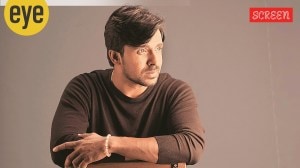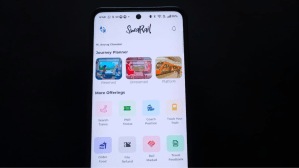42-year-old with blurry vision didn’t know he had blood sugar: How AI tool by AIIMS prevented diabetes damage to his eyes
Diabetic retinopathy doesn’t show signs at an early stage and can lead to complete vision loss. The tool helps with timely intervention
 The AI software was initially tested on AIIMS images taken by both high-end and low-end cameras. (Express photo by Ankita Upadhyay)
The AI software was initially tested on AIIMS images taken by both high-end and low-end cameras. (Express photo by Ankita Upadhyay)Two weeks ago, Ramnath Prajapati, a 42-year-old tailor from Bareilly in Uttar Pradesh, had dismissed his patchy, blurry vision at night as a minor eye problem. But a simple screening at an AIIMS outreach clinic at Trilokpuri in Delhi, which uses AI for diagnosis, revealed he had diabetic retinopathy, where high blood sugar damages the blood vessels in the retina, even leading to blindness. The quick diagnosis alerted him to a condition he never knew he had lived with for years.
That AI can help in monitoring public and community health is visible from the long queue outside the AIIMS Rotary Midtown Eye/Dental Hospital in Trilokpuri where optometrist Ananya Tripathi uses a fundus camera to take retinal images of the eye. She then runs them by an AI software named MadhuNetraAI, which analyses the scans based on the database of signs and symptoms it is equipped with and makes a diagnosis. Algorithms, trained on vast datasets of labelled images, can detect signs of diabetic retinopathy with high accuracy and efficiency. “Diseases like glaucoma and diabetic retinopathy don’t show signs at an early stage and can lead to complete vision loss. That’s where this AI tool helps with timely intervention,” she says.
The AI software has been developed in conjunction with the Union Ministry of Health and Family Welfare and Wadhwani AI, an independent non-profit institute developing AI-based solutions. It has been deployed at 21 rotary centres of AIIMS across Delhi for screening patients with diabetic retinopathy. Once screened, patients are referred to the institute for a thorough diagnosis and treatment.
“These AI-aided screening centres have been very helpful in diagnosing patients in the initial stages as many don’t get diagnosed till complete vision loss. Those found with the symptoms are then sent to the AIIMS RP Centre OPD for further treatment. It also helps in making up for fewer ophthalmologists in the hinterland,” says Dr Praveen Vashisht, professor and head, Community Ophthalmology, Dr RP Centre, AIIMS.
Why early detection is important
In the initial stages, the patient may not even have significant vision problems. “Now we advise patients to do a retina check-up at least once a year. With the AI screening tool, we can spot the changes early. Then some of them can be treated and reversed. But if they are long-standing, the changes might be so marked that the treatment might not help them fully,” says Dr Rohan Chawla, professor at RP Centre.

He estimates that with India becoming the diabetes capital of the world, 20-30 per cent of patients will develop retinopathy over the next five to 10 years. “We don’t have so many ophthalmologists let alone retina specialists in the country. So AI can help with the screening. As of now, we can take photographs of the retina with special cameras. Now this image goes via a tele-ophthalmologist to a doctor for analysis. This clearly requires more manpower and time. AI can tell you on the spot if the patient has diabetic retinopathy and requires early or late referral,” he says.
How AI was trained to read symptoms
The AI software was initially tested on AIIMS images taken by both high-end and low-end cameras. “Now we have achieved a good sensitivity and specificity for detection of diabetic retinopathy. The algorithm helps us classify the cases into mild, moderate and severe cases,” says Dr Chawla.
He says teaching AI was just like teaching any other student. “First you will teach a student what all to see. Once the student picks up features from several cases and makes a pattern, then they know which is diabetic retinopathy, which is not or what grade it is at. When the student passes the test of accuracy, you know that they can diagnose it correctly. Same with AI,” he explains.
So as doctors fed in images labelling signs and symptoms, the algorithms learnt them and made their own patterns and connections. “If the accuracy is above 94 per cent, we know that the algorithm has understood what we are trying to teach it. In this case it was 95 per cent,” he adds.
So how was the AI software developed?
First, AIIMS doctors put together the data of around 10,000 patients. These images were used to develop algorithms which were then validated for accuracy. Dr Chawla says the patient data was kept anonymised for the software and doctors could access it with the help of a UHID (Unique Health Identification Number).
According to Harshvardhan Singh, project manager at Wadhwani AI, MadhuNetrAI has been designed as a device-agnostic tool. It automatically detects the presence and severity of diabetic retinopathy, classifying patients as referable or non-referable. “The software can be used in public healthcare facilities, enabling field-level screening, supporting frontline healthcare workers and facilitating timely referrals to prevent vision loss. In this clinical validation, the AI model demonstrated strong performance with a sensitivity of 94 per cent, specificity of 96 per cent and overall accuracy of 95 per cent,” he says.
AIIMS is also bringing its own AI technology in the next six months to diagnose diabetic retinopathy and glaucoma for which research is under way.
Must Read
Buzzing Now



May 18: Latest News
- 01
- 02
- 03
- 04
- 05






















